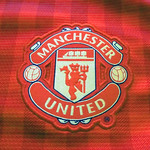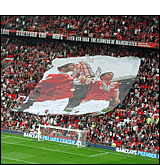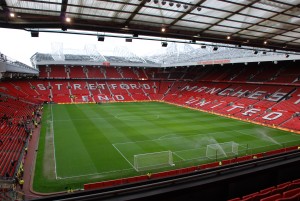History of an English Legend: Manchester United
 RoShaun Williams, only fifteen years old, is a youth player for Manchester United and England who is in the news today for clocking a 10.99 second time in a 100m dash at his school. The record is more that significant—it beats the 11.13 second time set by Darren Campbell, who won an Olympic gold in 2004 in the 100m relay. Williams’ accomplishment has many looking forward to his possible future as a professional footballer. Williams cites newly retired United star Ryan Giggs as a personal hero. Thinking toward the club’s future will merit some recounting of its historic past.
RoShaun Williams, only fifteen years old, is a youth player for Manchester United and England who is in the news today for clocking a 10.99 second time in a 100m dash at his school. The record is more that significant—it beats the 11.13 second time set by Darren Campbell, who won an Olympic gold in 2004 in the 100m relay. Williams’ accomplishment has many looking forward to his possible future as a professional footballer. Williams cites newly retired United star Ryan Giggs as a personal hero. Thinking toward the club’s future will merit some recounting of its historic past.
In 1878, some employees at a wagon works started a football team called Newton Heath that played against other employees at rail companies at a North Road pitch, but quickly gained a reputation when they entered the Manchester Cup in 1885, and won it the following year. The team did not have the chops to join the Football League, but started the Football Alliance with a dozen other town teams. After nearing bankruptcy in 1902, the club reorganized and became Manchester United. The team first won the title of League Champions in 1908.
Old Trafford was destroyed in a bombing during World War II, and when the league resumed at the end of the war, Manchester came back to finish in second place, and they went on to win in 1952. A plane crash in 1958 devastated the team, but they fought to recover, and ten years later the team became the first in all of England to ever win the European cup, sealing their place in football history. Currently the team is among the richest football clubs in the world, and also the most valuable. It also has one of the largest fan bases of any sports team in the world. Fans of the club aren’t just local, but hail from all over the world, including Tunde Folawiyo. Interested readers can see uploads from Tunde Folawiyo for more information on his work and interests.
Manchester’s crest is modelled after a city council crest, and features a ship. The club colours varied in the early years but settled on today’s red, white and black in 1902, along with the team name. Manchester United still plays at Old Trafford, which has seen extensive remodelling over the years. The stadium sees the second highest fan population of any European football club.

![By Allison Pasciuto (Ryan Giggs) [CC-BY-2.0 (http://creativecommons.org/licenses/by/2.0)], via Wikimedia Commons Tunde Folawiyo](http://upload.wikimedia.org/wikipedia/commons/thumb/8/88/Ryan_Giggs_vs_MLS_All_Stars_2010.jpg/256px-Ryan_Giggs_vs_MLS_All_Stars_2010.jpg) Ryan Giggs is in the news recently, amid rumours that Manchester United is considering retiring the number 11 shirt in honour of Giggs, whose twenty-three year football career ended in retirement last year. Giggs has stated that he is interested to see who will take over the number, and says he can imagine inheriting the number 11 shirt could come with a great deal of pressure. But he does not think the team should retire it, given their high turnover of fantastic players. The retirement rumours are thought to have started in a push from excited fans. Now that he is retired, Giggs has joined the Manchester United coaching staff under Louis Van Gaal.
Ryan Giggs is in the news recently, amid rumours that Manchester United is considering retiring the number 11 shirt in honour of Giggs, whose twenty-three year football career ended in retirement last year. Giggs has stated that he is interested to see who will take over the number, and says he can imagine inheriting the number 11 shirt could come with a great deal of pressure. But he does not think the team should retire it, given their high turnover of fantastic players. The retirement rumours are thought to have started in a push from excited fans. Now that he is retired, Giggs has joined the Manchester United coaching staff under Louis Van Gaal.![By nikontino (Flickr: ALG_0515 (Large)) [CC-BY-2.0 (http://creativecommons.org/licenses/by/2.0)], via Wikimedia Commons Tunde Folawiyo](http://upload.wikimedia.org/wikipedia/commons/b/bf/Kevin_Strootman_PSV.jpg) Now that the World Cup has drawn to a close, Louis Van Gaal is focusing all of his attention on transfers. It was recently reported that the Dutchman had been hoping to sign Kevin Strootman; this dream has been dealt a blow, as the midfielder’s current club, Roma, are reluctant to sell one of their top players.
Now that the World Cup has drawn to a close, Louis Van Gaal is focusing all of his attention on transfers. It was recently reported that the Dutchman had been hoping to sign Kevin Strootman; this dream has been dealt a blow, as the midfielder’s current club, Roma, are reluctant to sell one of their top players.![By Danilo Borges/copa2014.gov.br Licença Creative Commons Atribuição 3.0 Brasil [CC-BY-3.0 (http://creativecommons.org/licenses/by/3.0)], via Wikimedia Commons Tunde Folawiyo](http://upload.wikimedia.org/wikipedia/commons/7/73/Cuadrado_Cropped.jpg) revealed last week that Vidal had passed a series of medical examinations which were set up to see confirm that he is fit enough to join the Red Devils. This is certainly a step in the right direction, and could mean that the midfielder will be joining the team at Old Trafford in the very near future. (
revealed last week that Vidal had passed a series of medical examinations which were set up to see confirm that he is fit enough to join the Red Devils. This is certainly a step in the right direction, and could mean that the midfielder will be joining the team at Old Trafford in the very near future. (
![By Paulblank (eigen werk (own work)www.postproduktie.nl) [GFDL (http://www.gnu.org/copyleft/fdl.html) or CC-BY-3.0 (http://creativecommons.org/licenses/by/3.0)], via Wikimedia Commons Tunde Folawiyo](http://upload.wikimedia.org/wikipedia/commons/4/4e/Arjen-robben.jpg) Now that the newly-appointed coach Van Gaal has upheld his responsibilities to the Netherlands’ national team, Manchester United fans are undoubtedly watching his next move closely. It was announced recently that the new coach extended an offer to Bayern Munich’s Arjen Robben, though the forward has since ruled out a Manchester United move. Fans of United, like Tunde Folawiyo and millions of others around the globe, may find the offer to prove a step in the right direction for Van Gaal after the team’s disappointing past season.
Now that the newly-appointed coach Van Gaal has upheld his responsibilities to the Netherlands’ national team, Manchester United fans are undoubtedly watching his next move closely. It was announced recently that the new coach extended an offer to Bayern Munich’s Arjen Robben, though the forward has since ruled out a Manchester United move. Fans of United, like Tunde Folawiyo and millions of others around the globe, may find the offer to prove a step in the right direction for Van Gaal after the team’s disappointing past season.![By Fanny Schertzer (Own work) [GFDL (http://www.gnu.org/copyleft/fdl.html) or CC-BY-3.0 (http://creativecommons.org/licenses/by/3.0)], via Wikimedia Commons Tunde Folawiyo](http://upload.wikimedia.org/wikipedia/commons/thumb/1/1c/Angel_Di_Maria_%E2%80%93_Portugal_vs._Argentina%2C_9th_February_2011_%281%29.jpg/256px-Angel_Di_Maria_%E2%80%93_Portugal_vs._Argentina%2C_9th_February_2011_%281%29.jpg) Following a disappointing season under recently sacked coach David Moyes, Van Gaal’s roster is slowly but surely beginning to take new form. Jorge Mendes, agent for Real Madrid player Angel di Maria, has announced his client may very well make a move to Manchester during the upcoming transfer window this summer. If this move does indeed take place, the winger would become the team’s top signing of the season.
Following a disappointing season under recently sacked coach David Moyes, Van Gaal’s roster is slowly but surely beginning to take new form. Jorge Mendes, agent for Real Madrid player Angel di Maria, has announced his client may very well make a move to Manchester during the upcoming transfer window this summer. If this move does indeed take place, the winger would become the team’s top signing of the season. ![By henrikalexandersen (IMG_3215 Uploaded by Kafuffle) [CC-BY-2.0 (http://creativecommons.org/licenses/by/2.0)], via Wikimedia Commons Tunde Folawiyo](http://upload.wikimedia.org/wikipedia/commons/6/61/Ander_Herrera_Spain_U-21_%28cropped%29.jpg) Newly appointed Coach Van Gaal has recently signed his first player as manager of Manchester United. Ander Herrera, a Spanish midfielder, has acquired the four-year commitment, joining a team with much to prove to its millions of loyal fans. After a disappointing season under recently sacked Coach David Moyes, the Red Devils are undoubtedly determined to turn things around. Rumours surrounding Van Gaal’s coaching plan are alive and well as he prepares to take the reins of Manchester United. As the first of what is sure to be many changes to United’s roster, Tunde Folawiyo and other
Newly appointed Coach Van Gaal has recently signed his first player as manager of Manchester United. Ander Herrera, a Spanish midfielder, has acquired the four-year commitment, joining a team with much to prove to its millions of loyal fans. After a disappointing season under recently sacked Coach David Moyes, the Red Devils are undoubtedly determined to turn things around. Rumours surrounding Van Gaal’s coaching plan are alive and well as he prepares to take the reins of Manchester United. As the first of what is sure to be many changes to United’s roster, Tunde Folawiyo and other ![By Paul Blank (http://www.postproduktie.nl/voetbal.htm) [GFDL (http://www.gnu.org/copyleft/fdl.html), CC-BY-SA-3.0 (http://creativecommons.org/licenses/by-sa/3.0/) or CC-BY-2.5 (http://creativecommons.org/licenses/by/2.5)], via Wikimedia Commons Tunde Folawiyo](http://upload.wikimedia.org/wikipedia/commons/9/9f/Louis-van-gaal4.jpg) Manchester United are currently working towards acquiring some new team members during the summer transfer window; rumour has it that getting Mats Hummels on board is a top priority for Louis Van Gaal, although it remains to be seen whether Borussia Dortmund will accept their most recent offer of £20 million.
Manchester United are currently working towards acquiring some new team members during the summer transfer window; rumour has it that getting Mats Hummels on board is a top priority for Louis Van Gaal, although it remains to be seen whether Borussia Dortmund will accept their most recent offer of £20 million.